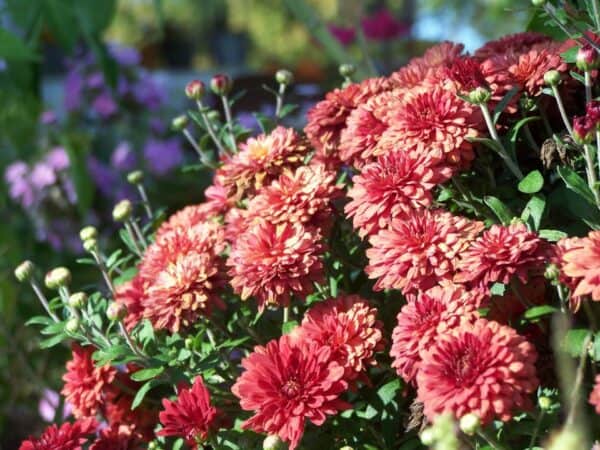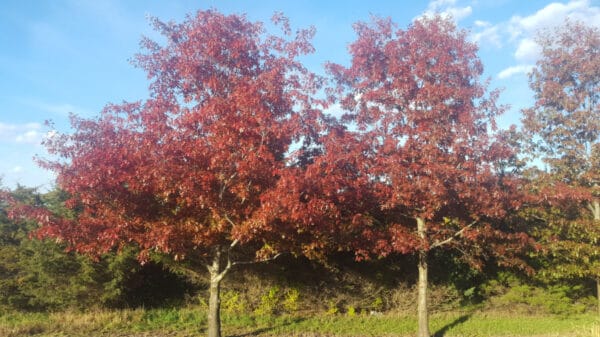Lawn
• Fall leaves should be removed to prevent suffocation and death of the grass. Rake them if they are piled heavily or mow them. A mulching mower will chop them finely and add humus to the soil.
• Spray for weeds. Dandelions, henbit and chickweed are best controlled in the fall when the plants are young.
• Continue to mow the lawn if necessary, bluegrass 2 inches, tall fescue 2½ inches.
• Core aerate turf to reduce soil compaction, improve drainage, break up thatch, and help nutrients move into the soil.
• Sharpen mower blade for a clean cut.
• Check oil level in your lawn mower.
Landscape
• Time for fall cleanup. Remove any fallen fruit, leaves, branches and cut weeds back as a good sanitation practice. This will prevent over-wintering of insects and diseases!
• Time to spray Lime Sulphur on old roses susceptible to diseases and fruit trees to clean-up fungus and prevent it from overwintering on fallen debris.
• Move all chemicals inside to a location where they will not freeze. Most liquid chemicals lose their potency if they have been subjected to extreme cold temperatures.
• Remember to unhook all your hoses and your Drip Irrigation from your hydrant before the first frost. All water in the rubber hoses will drain. Make sure all garden hose are unhooked from all your hydrants.
• Have your irrigation system blown out to remove water and prevent pipes from breaking in the winter.
• Prepare the compost pile for winter. Add new materials and turn.
• Store unused seeds in a cool, dry location.
Vegetables and Fruits
• Plant garlic cloves for next summer’s harvest. Fall planting gets a jump on spring conditions.
• After a light frost, dig sweet potatoes and cure them for two weeks in a warm location. Then store in a cool, dry location for longer keeping.
• Harvest peanuts and roast for a homegrown snack.
• Pick pumpkins and winter squash. Keep in a warm area for a couple of weeks, and then store in a cool, dry location.
• Till the garden at the end of the season and add organic matter such as manure or compost to improve the soil structure.
• Make notes of successes and failures in the garden for next year.
• Remove hulls from black walnuts to retain good color of the kernels.
• Continue to harvest apples.
• Pick up and discard fallen fruit to reduce disease next year.
Flowers
• Plant Fall Bulbs, such as tulips, daffodils, and crocus, for a splash of early season color. Choose a sunny to part shade location with good drainage.
• Remove dead annuals from the garden.
• Trim perennial stalks to tidy the garden for winter.
• Pot bulbs for indoor forcing.
• After a light frost, dig canna, glads, dahlias and other tender bulbs for winter storage.
• Make notes about the garden to document successes and failures.
• Clean up dead iris and peony foliage and destroy it to decrease the spread of disease. Iris are known for a couple of common problems: a fungus disease known as iris leaf spot and an insect called the iris borer. Though both cause problems in the spring, now is the time to start control measures. Both the fungus and eggs of the borer overwinter on old, dead leaves. Removing iris leaves and other garden debris from the iris bed this fall reduces populations of these pests. This can significantly reduce problems next spring.

Trees and Shrubs
• Fertilize all trees & shrubs in late September to mid-October. You may only fertilize now, or fertilize in spring and fall. Depends on the health of the shrubs and the growth rate you want to achieve. For example if you want your trees to grow at a faster rate, fertilize both in the spring and in the fall. Fertilize with Tree & Shrub Fertilizer (Ferti-lome brand = 19-8-10) or Osmocote fertilizer. Depending on the size of the shrub ½ cup to 1 cup per shrub and water it in well.
• Place tree wrap around the bark of young trees. This will prevent sun scorch when the leaves drop and the bark is exposed all winter. It will also prevent pesky rabbits from chewing on the tender bark. Protect the bark, it is like our skin, it is a protective layer to prevent infection and invasions that cause damage and diseases.
• Plant new trees and shrubs. Water new and establishing plants to send them into winter with ample moisture. Need some shade or ornamental trees? Now is the best time to plant trees (with the exception of Redbud, Dogwood, & Birch as they root slowly and may not be prepared for winter). Plant the exceptions in the spring.
• Once the leaves have fallen, transplant trees and shrubs.
• Enjoy fall leaf color, which normally hits it peak about the third week of October.

Pruning
• Trim dead, broken, or diseased branches from trees and shrubs.
This information is brought to you from Nadine Champlin, Designer, Grimms Gardens; and Johnson County K-State Research and Extension. http://www.johnson.ksu.edu/p.aspx?tabid=145


